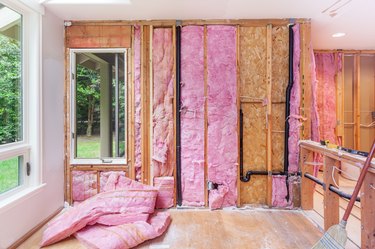
When you need to attach something to a ceiling, such as a drywall overlay, a light fixture, a fan or even a plant hanger, you need to know where the joists are. Locating them is often straightforward, and the methods for finding them are the same whether the ceiling is in the house, the garage or even on a covered porch. Uniform building standards require precise joist spacing to accommodate sheet-type materials, like drywall and plywood, so finding one joist makes it simpler to find the rest.
Stud Finder
Video of the Day
Although ceiling joists are not studs -- studs run vertically in walls -- a stud finder is an excellent way to locate them in a drywall-covered ceiling. High-quality stud finders are pricey, but you can rent one from a construction supply rental store for a reasonable fee. The best stud finders locate the outer edges of a joist, which then allows you to pinpoint the joist's exact center. Digital displays vary depending on the brand of stud finder, but they all work by sliding the finder along the ceiling until it senses a joist. Not everyone wants to run out and rent or buy a stud finder, though, and while it's a handy tool, you can locate ceiling joists without one.
Video of the Day
Tapping and Test Holes
The tapping-detection method requires paying close attention to subtle changes in the way the ceiling feels and sounds as you tap. Tapping, with knuckles or lightly with a hammer, between joists, produces a hollow or echo sound. Tapping over a joist sounds more solid.
When you think you've located a joist, drive test nails to find the exact edges and the center of the joist. When you hit a joist, the nail will be difficult to drive, but when you miss the joist, it will slip through the drywall easily. You might end up with a few test holes, but you can fill them later with drywall compound or putty.
Detect by Measuring
When you've located the edge of one joist -- measure back ¾ inch to find the joist's center, and then measure over 16 inches to find the center of the next joist. If you come up empty, try measuring 24 inches from the center of the first joist. While many ceiling joists are on 16-inch centers, some are on 24-inch centers. Don't guess where additional joists are. If you're installing drywall, locate and snap chalk lines on the centers of every joist.
Plaster Ceilings
Some historical homes still have thick plaster ceilings, and this makes it tricky to find joists. A stud finder is impractical on plaster, and tapping is useless. If you have access to the attic, measure from a sidewall to the nearest parallel joist and then transfer that measurement to the ceiling below. Confirm by making test holes with a long nail or a 1/8-inch drill bit.
One of the biggest problems with joist placement in old plaster ceilings is that while the joists might be evenly spaced, there's no guarantee because sheet material was not in use during construction, so uniform spacing was frequently ignored. The only reliable way is to make test holes to locate the edges and centers. Keep test holes a couple of inches away from the wall all the way across the ceiling on both sides. Old joist configurations can be off-kilter, so locate each joist individually and snap chalk lines to indicate the centers.